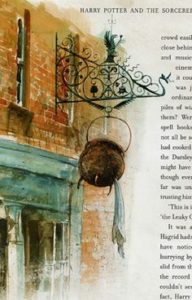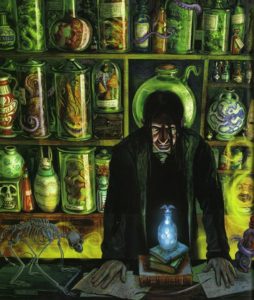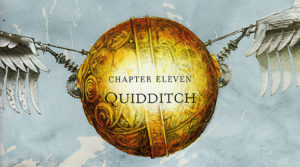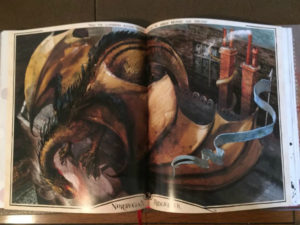Easter Eggs in Jim Kay’s Illustrations for “Harry Potter and the Sorcerer’s Stone”
by John Jennette
It’s been just over two months since the illustrated Harry Potter and the Sorcerer’s Stone was released, and I have not been able to get enough of Jim Kay’s stunning watercolor illustrations. I don’t know how anyone else could make the Hut on the Rock look that gorgeous, and I still can’t tear my eyes away from the spreads showing Hogwarts through the year. Going back a second time, I started noting more interesting little details. As I delved further, I discovered that there was much more. Because of these details and personal touches, I feel even more confident in Mr. Kay’s care, dedication, and knowledge about the world he is imagining for us all, and [I] can’t wait for the next installment.
Any interpretations herein are my own, as a fan and a true Ravenclaw. My research started at Jim Kay’s website – www.jimkay.co.uk – and any other information was delivered by my good friend, [t]he Internet. I know that nobody but Mr. Kay will know all of the hidden meanings and references in his work, and I only highlight a few of the pictures here, but nevertheless, there is plenty that a sharp eye and a keen mind can puzzle out.
Frontispiece
The “LC” on the trunk likely stands for Louise Clark, Jim Kay’s partner.
Page 58: THE LEAKY CAULDRON
For such a simple prop, the sign for the Leaky Cauldron is stuffed with references. In the wrought-iron bracket you can find:
- the HOPPING POT (from the eponymous Beedle fairytale)
- a MANDRAKE and Babbity Rabbity’s CACKLING STUMP clustered around
- the first DEATHLY HALLOWS symbol of the book.
- Under all of that, a GOLDEN SNITCH acts as the hook to hold up the Leaky Cauldron sign itself.
Page 60-61: DIAGON ALLEY PART 1
BUFO, unsurprisingly, is Latin for “toad.” BATRACHIAN means “of or relating to frogs or toads.”
Pages 62-63: DIAGON ALLEY PART 2
- NOLTIE’S GREENHOUSE: Jim Kay – like all good Englishmen – is a great lover of gardens and the natural world. He has worked at the Royal Botanic Gardens Kew and keeps a small but well-kept garden at his Northamptonshire home. Henry Noltie is a research associate at the Royal Botanic Gardens Edinburgh.
- JANUS GALLOGLASS: Janus is the Roman god of beginnings, transitions, and doorways, an appropriate name for a mirror purveyor. The Galloglass was a class of elite Norse-Gaelic mercenary warriors in the 13[th]–16[th] centuries. The name is derived from [the] Irish gallóglaigh, which means “foreign young hero,” which, to most of the world, describes Harry Potter pretty well.
- A PSYCHOMANTEUM is used in parapsychology and spiritualism. It is a small, dimly-lit [sic], enclosed room with a chair and a mirror used to communicate with spirits.
- CATOPTROMANCY is – you guessed it – divination using a mirror.
- The shop next door, PRAEDICO PREDICO, uses two languages to say the same thing. Praedico is Latin for “I proclaim” or “I foretell,” and predico in Spanish and Italian means “I preach.”
- The dog laying outside of Belcher’s is Jim Kay’s greyhound Leroy.
Pages 80-81: PLATFORM 9 ¾
Though it may reference the creator herself, the “JK” on the trunk behind the bewildered Harry more likely stands for “Jim Kay.” Looks like somebody’s going to Hogwarts!
Page 84: DUMBLEDORE’S PORTRAIT
Dumbledore has an interesting portrait. There’[re] the obvious Muggle lemon drops and a half-finished knitting project lying close at hand.
- The plant is a LUNARIA ANNUA, a.k.a. annual honesty. Lunaria is Latin for “moon-shaped.” This plant has many regional names such as “silver dollars” (United States), “coins of Judas” (Denmark), and “the Pope’s money” (France). Surprising no one, it represents sincerity.
- The PRAYING MANTIS is an interesting addition to a portrait, no? Mantis is Greek for ‘prophet,’ and mantises[‘] slow, careful movements embody patience, meditation, and contemplation.
With this portrait, Dumbledore is depicted as a patient, sincere wise man. He asks for trust and honesty. Whether he is worthy of that trust, and whether he was as transparent as the seedpods indicate, are central themes of his character.
Page 110: THE POTIONS MASTER
This illustration has the most interesting symbolism, if you ask me. First of all, Snape’s head is surrounded by a halo-like jar that sets him apart from the rest of the chaos behind him. There is a lot going on back there, but two things leap out and highlight this character’s true allegiances:
- The MONKEY SKELETON on Snape’s desk fits the dungeon’s creepy vibe. However, monkeys are generally symbols of devotion, protection, and cleverness. The Hindu monkey god Hanuman is a model of devotion and bravery, performing incredible feats through his love of Rama. In Chinese Buddhism, the Monkey King Sun-Wukong is a trickster figure, hinting at Snape’s double-agent deception. In Japanese Shinto mythology, monkeys are protectors against demons, and the famous “see no evil, hear no evil, speak no evil” monkey trio originates from this tradition. Strong indication right off the bat that Snape is good, for those who know their symbolism.
- While the monkey hints at Snape’s allegiance, the Ancient Egyptian CANOPIC JAR just behind the skeleton sheds light on his motives. This particular jar holds a dead person’s stomach and features the jackal-headed Duamutef, son of Horus and Isis. Duamutef means “he who adores his mother,” and his role was to worship the deceased one. According to Egyptian mythology, Duamutef was born from… a lily flower.
Page 149: CHAPTER ELEVEN[:] “QUIDDITCH”
The Snitch has an Old English inscription around its circumference. What is visible reads “MEC HEHT WYRCAN,” which translates to “He called me to work.” This could be a reference to Bowman Wright, the creator of the Golden Snitch. However, if this Snitch is the one used in this chapter’s Quidditch match, that makes it the “open at the close” Snitch; this inscription may be overwritten in short order…
Page 150: HERMIONE GRANGER
This illustration like this is begging for an artist to hide references. You could spend an hour reading all the names carved into the wooden door and not catch everything. Not only are there a bunch of Potter names (marked in white) but [also] many related to Jim Kay as mentioned in the acknowledgements or on his site (marked in blue) and a few more that were just plain interesting (marked in green). The painting has been adjusted to more clearly read the carvings. I would not be surprised if every name on here meant something, but without Mr. Kay’s say so, these were all that I could find citations for:
- Potter Names: “JKR” accompanies an inkpot and quill at the very top, bathed in golden light; LUPIN drew a moon next to his name (very subtle, Remus); SNAPE; T. RIDDLE; SCRIMGEOUR; P. PARKINSON; THOMAS; A. MOODY; WEASLEY; GARRIK could be Mr. Ollivander, though it is spelled differently. The date next to the name is also not congruous with the wandmaker; a namesake?
- Acknowledgement Names: The “LC” in a heart is a reference to Mr. Kay’s partner Louise Clark; Clive Lundquist is a Botanical Sciences PhD at the University of Bristol – there is a second “LUNDQ” just above his name; Henry Noltie of the Royal Botanic Gardens Edinburgh shows up again; Dr. David Goyder works at the Royal Botanic Gardens Kew, where Jim Kay also worked; A.T. Maddox most likely references Anthony Maddock from the acknowledgements; Brecht Evens is a Belgian cartoonist who is linked to on Kay’s site; Alison Eldred is Mr. Kay’s agent.
- Jim Kay did concept art for the BBC miniseries Jonathan Strange & Mr Norrell, so of course the English magician carved his name as well.
- A few other notable items: HAGGARD calls to mind our lovable half-giant; the B.B. with a bird could be Barb[e]rus Bragg[e], who introduced catching the Snidget to Quidditch. It could also be Bathilda Bagshot or even the Ballycastle Bats. “G.G.” might be Gregory Goyle (though drawing a coat of arms seems a little out of his comfort zone) or Gellert Grindelwald. “P.P.” could be Peter Pettigrew or one of the Patil twins. The carving of a boat and the date 1874 is interesting because in that year an Arab-class gun-vessel was launched name[d] the HMS Lily. It didn’t seem to do anything notable before wrecking off the coast of Labrador in 1888, but it’s interesting nonetheless.
- Oh, and there’s another Deathly Hallows – number two – as well as an anchor and an acorn/oak leaf, common motifs throughout the book.
Page 194: NORBERT LEAVES
There isn’t anything particular to note about this painting except that I find it interesting that the Astronomy Tower seems to have an airplane warning light at the top. To notify any low-flying broomsticks? Also of note, in the short film about Jim Kay’s work on his site[, a] sketch is revealed showing that the tower is meant to open up to reveal the Astronomy telescope. Pretty neat!
A few motifs are recurring through the book and possibly the whole series – we shall have to wait and see. I found the Deathly Hallows symbol three times in […] Sorcerer’s Stone (pp. 58, 150 & 177), and I am sure that will continue to the other books. In the text, the introduction of the Deathly Hallows in Book Seven was abrupt and unexpected; at least in the illustrated versions, readers might not be so blindsided. A recurring design is the oak leaves and acorns. The oak is the mightiest of trees – strong, resilient, noble, and above all, English. That such a majestic tree can come from a tiny acorn is in itself magical, much like the Harry Potter series (and J.K. Rowling herself) grew from humble beginnings into a global phenomenon. Jim Kay is fascinated with the natural world in his garden, and I counted 18 spiders. Finally, anchors pop up here and there throughout the illustrations. This seems to be something more personal to Jim Kay, and I don’t have an explanation without more information, but I do keep an eye on them.
Oak/Acorns:
Pg. 58: Leaky Cauld[r]on: acorns on Leaky Cauldron sign
Pg. 60: Diagon Alley [P]art [O]ne: acorn cornices above Diagon Alley sign
Pg. 93: Chapter 7 ([“T]he [S]orting [H]at[“]): masonry under windows
Pg. 122: Malfoy takes the Remembrall: yellow oak tree
Pg. 150: Hermione: oak leaf and acorn above SCRIMGEOUR
Pg. 173: Dumbledore and Harry and the Mirror: on table
Pg. 196: Chapter 15 ([“T]he [F]orbidden [F]orest[“])
Pg. 198: above Gryffindor hourglass
Pg. 224: Flying Keys: key with crumpled wing
Pg. 234: The Man with Two Faces: around the mirror
Anchors:
Pg. 150: Hermione: Anchor to the left of LUPIN
Pg. 225: Flying Keys: key in top left corner
Deathly Hallows:
Pg. 58: Leaky Cauldron: on Leaky Cauldron’s sign
Pg. 150: Hermione: to the left of A. MOODY
Pg. 177: On bottom book’s spine
Spiders:
Pg. 14: Chapter 2: [“]The Vanishing Glass[“]
Pg. 16: Cupboard Under the Stairs: seven spiders, 4 on facing page
Pg. 70: Purple wand cushion
Pg. 134: Chapter 10: [“}Hallowe’en[“]
Pg. 150: Hermione: Carving of a spider (near W. WOOLLEY)
Pg. 159: Chapter 12: [“]The Mirror of Erised[“]
Pg. 196: Chapter 15: [“]The Forbidden Forest[“]
Pg. 212: Chapter 16: [“]Through the Trapdoor[“]
We want to thank John for this amazing analysis! Did you see anything that he missed? Be sure to leave it in the comments below!








